Most marine protection measures are not working – a new, more flexible approach is needed

The radio crackles into life on a small boat off an idyllic beach in Ningaloo Marine Park, Western Australia. Two recreational fishers are trying to catch prized spangled emperors in a sanctuary zone, where all fishing is supposed to be banned, to help protect this fish from overfishing.
A recreational fisher further down the coast is using his radio to alert others of the imminent arrival of marine park wardens in a patrol boat. The two fishers calmly stash their rods, power up the large outboard engine, and motor away from the sanctuary zone. By the time the wardens arrive, all appears calm and well. This scenario illustrates how challenging it can be protect marine wildlife from the sometimes damaging effects of human activities, such as fishing.
Almost every country in the world is trying to achieve an internationally agreed legal target to protect 30% of their land and sea area by 2030. Setting up marine protected areas, such as marine parks, is an important way of achieving this target. But they have to be effective in actually reducing the negative effects of human activities, as well as fair to local people in avoiding excessive restrictions. There are concerns that the race to create more marine protected areas or underwater nature reserves could be distracting governments from the challenges of ensuring that conservation measures are as effective as possible in fairly reducing harm from human activities that threaten marine wildlife, such as fishing and tourism.
To explore different ways of addressing such challenges, our research assessed the effectiveness of 50 marine protected areas in 24 countries, from Ecuador to Madagascar and Vietnam. We compared the strengths and weaknesses of different conservation measures for protecting marine wildlife by using a set of 36 “governance incentives” – these include providing financial compensation, requiring legal accountability and establishing local groups that encourage community participation in discussions, decisions and related research.
Working with 70 researchers from various countries, we interviewed around 20 people involved in each of the 50 marine protected areas, from fishermen to tourism operators and recreational sea users. We also analysed marine conservation measures to see how effective they were and observed day-to-day activities on the coast.
Our aim was to understand how people perceive the effectiveness of some of these marine conservation measures and explore their views about which activities, such as fishing, could be better managed.
The 50 MPAs scored a low average of 2/5 for effectiveness – a lot of protective conservation measures were in place on paper but they were not effective in reducing the harmful effects of certain human activities to protect marine wildlife. This reveals the need for these marine protected areas to make a more tangible difference, rather than just being what many term “paper parks”, that exist in legal texts but not in practical reality.
Our research confirms that there’s no one key to success – different combinations of conservation measures work best to improve effectiveness in different locations. One clear overall trend was that a more diverse mix of management approaches resulted in greater reduction of the effects of fishing, tourism and other human activities.
Tackling illegal fishing
In Western Australia, Ningaloo and Shark Bay marine parks demonstrate how this can be done relatively well to reduce negative effects and better conserve marine wildlife. Here, fisheries officers enforce legal restrictions on recreational fishing, which has led to the recovery of some previously overfished populations, such as pink snapper, and increases in recreational fishing catches. But it can be challenging to prevent illegal fishing in remote no-take sanctuaries, as the scenario above illustrates. Recreational fishers who are caught breaking the rules are fined, but these fixed penalties are often not enough to discourage further illegal fishing.
Marine wildlife watching, particularly for whale sharks and bottlenose dolphins, is managed through a restricted number of licences for tour boats to operate. Legal conditions to prevent disturbance to whale sharks and dolphins are attached to these licences, enforced by vessels competitively watching each others operations, in the hope that they can acquire additional wildlife watching licences. Satellite surveillance and patrols by wardens helps to monitor wildlife watching vessels.
Ningaloo and Shark Bay marine parks also promote fairness to local people. The traditional ways of life of aboriginal Australians are respected and their understanding of ecosystems generated over many generations is learnt from. They are employed as wardens and research officers for the parks. Each of these two parks has a committee that provides for participation in discussions and decisions by local people representing different interests, including aboriginal Australians.
Ecosystems are more resilient to the impact of human activities if they support a wider diversity of species. Marine protected areas represent complex social and ecological systems, each interacting in different ways with local people in coastal communities. Our research shows that there’s no one-size-fits-all solution. There are examples of good practice, such as Ningaloo and Shark Bay marine parks, but even they aren’t perfect, as the challenge with illegal fishing illustrates. And what works in one situation may not work in another.
Our research also shows that to successfully protect 30% of their land and sea by 2030, governments and local people should use diverse management approaches in combination, rather than unrealistically seeking one best solution. The key to resilience is diversity, both of species in ecosystems and conservation measures in protected area management systems.
This article is republished from The Conversation under a Creative Commons license. Read the original article.

Peter JS Jones received funding for some elements of this research from the United Nations Environment Programme.
Rick Stafford does not work for, consult, own shares in or receive funding from any company or organisation that would benefit from this article, and has disclosed no relevant affiliations beyond their academic appointment.

 Yahoo News
Yahoo News 


